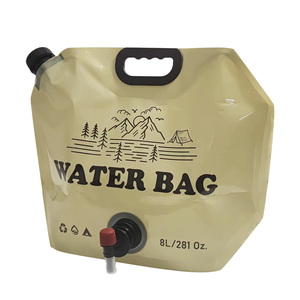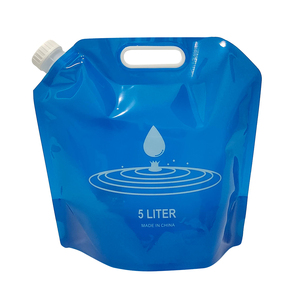
All categories
Featured selections
Trade Assurance
Buyer Central
Help Center
Get the app
Become a supplier

(968 products available)





















































A 1-gallon plastic liquid bag refers to such a bag manufactured from plastics, usually plastics of high density and low density. Such a liquid bag can contain as much as one gallon of liquid. Several types of these bags exist, and each serves unique needs. Here are some of them:
This is a simple and uncomplicated type manufactured from a flat plastic sheet. Usually, it has a wide opening that allows easy filling. It is used for packing liquids that do not need pressure, for instance, water or juices, since they are not intended to be consumed.
A zipper bag comes with a zip-lock mechanism that permits repeated use or resealing after the first use. Therefore, it is appropriate for storing liquids that need to be kept for some time, such as sauces or marinades. However, it is not as common as the flat bags. These bags are most appropriate for consumers and businesses that require frequent access to the liquid.
The modifications on gusseted bags enable them to expand on the sides. Hence, they become broader or roomier when opened. These are ideal for liquids that may require some space or bags that one would like to place on a rigid surface. The prosthetic features of the gusset allow the liquid bags to stand, thus aiding stability to the liquid inside.
These include a nozzle or spout for pouring, containing a closure that can be removed. These bags apply to liquids requiring accurate or controlled pouring, say, detergents or some industrial chemicals. Spout bags are also widely acceptable for food and beverage businesses.
Heat sealing is involved in the closing of these bags. Given that, they are best suited for liquids that require sterility and security, such as medical fluids or food items. The heat-sealed closure assists in better storage and makes challenging any form of contamination or tampering with the bag.
These bags are more than simple containers. They bear designs that enhance their functionality and add some aesthetics and class. Below are some of their notable designs:
1-gallon plastic liquid bags are subjected to some changes to increase their longevity and usefulness. These enhancements ensure such bags have security features, usability, and durability.
Many such bags are made from recyclable plastics. Hence, they can be used more than once. This lowers the environmentalist's impact and helps people cut their wastage and expenses as well.
Internal cushioning is great for preventing the contents from sloshing about inside the bag and, therefore, providing additional cushioning for sensitive liquids such as chemicals and liquid soap for bathing.
Many 1-gallon liquid bags come with anti-burst technology. This is due to the creation of pressure resistance. This allows the usage of such bags in industries where pressure fluctuation is a must.
These bags are manufactured using stoppers that block UV light. Such stoppers are normally used to secure materials that may break down when exposed to UV rays, including some chemicals and food items.
The spout of 1-gallon bags can be fitted with caps or plugs to ensure their contents are not contaminated and are always in good shape. These modifications are mainly for usage in the food and medical industries.
Moreover, systems with v functionalities are installed in such bags to release trapped air during filling. It improves the efficiency in the use of bags and the quality of liquids stored in them.
These bags are employed in various situations. Here are some of the commonest among them:
These bags are widely used in the industry for packaging liquids such as sauces, juices, and other beverages. This is because they are light, hard enough, and convenient to use. These bags preserve and protect the food content while also providing an attractive presentation mode.
These bags serve the same purpose in the household and industrial cleaning products as above. The bags are designed to contain liquid soaps, cleaners, or disinfectants safely. Their physical properties and versatility make them resistant to puncture and, thus, to leaks.
These bags also perform essential functions in the medical field. They are used to contain IV fluids, saline solutions, and other medicinal liquids. It is critical that the materials used be sterile and durable. Hence, the liquid bags are designed with heat sealing and other modifications that ensure sterility and durability.
Plastic liquid bags have a client base in agriculture, too. They package fertilizers, pesticides, and other chemicals. Usually, the fluids in these bags require not just hard-wearing materials but also UV protection and anti-burst technology.
Just like in the food industry, these bags allow for convenient handling and storage of lotions, shampoos, and other liquid cosmetics. Their light nature makes them easy to transport within manufacturing and retail environments.
Plastics liquid bags find many industrial applications beyond consumer goods. They store and transport chemicals, dyes, and other industrial liquids. The security features of these bags also guarantee the liquids inside are protected from spillage and contamination.
Details concerning specifications and care measures guarantee that 1-gallon plastic liquid bags serve their purpose reliably and over time. Here is a breakdown of what is most important:
A1: Yes, 1-gallon plastic liquid bags can be used for food storage. Just ensure that they are made from food-safe plastics, such as polyethylene.
A2: Most plastics used in making 1-gallon bags are not biodegradable. However, there are some biodegradable plastic liquids made from cellulose, cornstarch, and many other bio-based materials.
A3: 1-gallon plastic liquid bags are made from LDPE or HDPE. Low-density polyethylene (LDPE) is flexible, while high-density polyethylene (HDPE) is thicker and stronger.
A4: Yes, but one must be careful to mix them with water first. Water must first be added to these chemicals prior to storing them in plastic epoxy garage floor paint bags.
A5: One thing to do to minimize the impact of these plastic liquid bags is to recycle them. Users must return them to collection centers or drop them off at recycling bins.